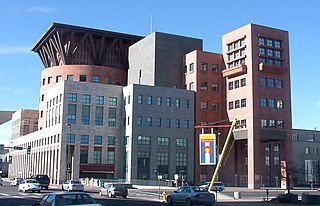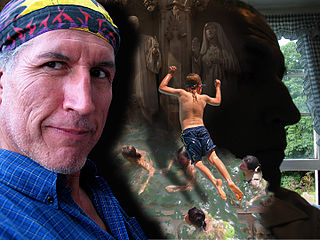Related Research Articles
Robert Adams is an American photographer who has focused on the changing landscape of the American West. His work first came to prominence in the mid-1970s through his book The New West (1974) and his participation in the exhibition New Topographics: Photographs of a Man-Altered Landscape in 1975. He has received two Guggenheim Fellowships, a MacArthur Fellowship, the Deutsche Börse Photography Prize and the Hasselblad Award.

Hal Gould was an American photographer and gallery curator. He was an advocate of fine art photography and created a venue which eventually became the Camera Obscura gallery at the Denver Art Museum.

The Denver Public Library is the public library system of the City and County of Denver, Colorado. The system includes the Denver Central Library, located in the Golden Triangle district of Downtown Denver, as well as 25 branch locations and two bookmobiles. The library's collection totals more than 2 million items, including books, reference materials, movies, music, and photographs. Of that total, more than 347,000 items are in specific collections including the Western History and Genealogy Department, Blair-Caldwell African American Research Library, and Reference Department holdings.

Fine-art photography is photography created in line with the vision of the photographer as artist, using photography as a medium for creative expression. The goal of fine-art photography is to express an idea, a message, or an emotion. This stands in contrast to representational photography, such as photojournalism, which provides a documentary visual account of specific subjects and events, literally representing objective reality rather than the subjective intent of the photographer; and commercial photography, the primary focus of which is to advertise products or services.

Laura Gilpin was an American photographer.
Eric David Kroll is an American photojournalist, fetish photographer, erotica historian, and book editor.

Francesca Stern Woodman was an American photographer best known for her black and white pictures featuring either herself or female models.

Theodore Brett Weston was an American photographer.

Gertrude Käsebier was an American photographer. She was known for her images of motherhood, her portraits of Native Americans, and her promotion of photography as a career for women.
Don Donaghy was a member of the New York school of photography.
George Edgar Woodman was an American ceramicist, painter, and photographer.

Jerry De La Cruz is an American fine artist born and raised in Denver, Colorado. He currently works out of his studio in the Santa Fe District in Denver, Colorado, and out of his studio in the Little River District in Miami, Florida.
John Fielder was an American landscape photographer, nature writer, the publisher of over 40 books, and a conservationist. He was nationally known for his landscape photography, scenic calendars and for his many coffee table books and travel guides—including Colorado's best-selling Colorado 1870–2000, in which he matched the same scenes of classic photographs taken in the 19th century by photographer William Henry Jackson.
Walter Landon Chappell was an American photographer and poet, primarily known for his black and white photography of landscapes, nature, and the human body.
David Lee DeHarport (1921-2001) was a photographer and anthropologist primarily known for his photographic work in Colorado's eastern plains region and his archaeological survey work of Arizona's Canyon de Chelly National Monument. Born on August 8, 1921, David DeHarport was raised in Denver, Colorado. He attended the University of Denver and studied photography and anthropology. After earning his B.A. in 1943, DeHarport received a Master's in anthropology in 1945.
The Aultman Studio was a commercial photographic studio that operated from 1889-2000 in Trinidad, Colorado. It is considered to be one of the longest running photography studios in Colorado.
Betty Hahn is an American photographer known for working in alternative and early photographic processes. She completed both her BFA (1963) and MFA (1966) at Indiana University Bloomington. Initially, Hahn worked in other two-dimensional art mediums before focusing on photography in graduate school. She is well-recognized due to her experimentation with experimental photographic methods which incorporate different forms of media. By transcending traditional concepts of photography, Hahn challenges the viewer not only to assess the content of the image, but also to contemplate the photographic object itself.
Fred Payne Clatworthy (1875–1953) was a landscape photographer who worked primarily out of Estes Park, Colorado. He was known for his work with the Autochrome Lumiere screen plate, an early color photography format.

Mark Sink is an American photographer best known for romantic portraiture. Some of his most recognizable images include documentation of life and work of artists such as Andy Warhol, Jean Michel Basquiat, Rene Ricard and other artists from the New York art scene of the 1980s, before returning to Denver. Mark Sink has been exhibiting his work professionally since 1978 to the present day from street art, commercial galleries, museums and other institutions.
Thomas Carr is an American archaeologist and photographer who has studied the intersection of anthropology and art with an emphasis on the abandonment of human built environments in the natural landscape. His academic work has been published in journals such as Archaeological Prospection and Colorado Heritage Magazine. He has lectured extensively on archaeology, photography, visual ethnography, and historic preservation. His photographic work in the Rocky Mountains region has been the subject of several major exhibitions and numerous group and juried exhibitions. The Western History and Genealogy Department of the Denver Public Library holds a collection of Carr's photographs in its permanent archives.
References
- 1 2 3 4 Paglia, Michael. (2011). Foreword. Winter Prather: the Blink of an Eye. Denver, Colorado: Michael Horsley. pp 4-11.
- ↑ Davidson, Lee (1995-04-08). "What Inspired Dugway N-Test Stories?". Desert News. Archived from the original on April 7, 2016. Retrieved 2016-03-27.
- ↑ Evans, Adrienne (2015-08-27). "Winter Prather: Colorado's Lost Master Photographer". History Colorado Blogs. Retrieved 2016-03-28.
- ↑ "Winter Prather collection," Finding aid at History Colorado Center, Denver, Colo
- ↑ Paglia, Michael (2011-03-11). "Z Art Department Salutes Nearly Forgotten Winter Prather". Westword. Retrieved 2015-03-28.
- ↑ "Winter Prather's Striking, Offbeat Photographs Shown". The Denver Post. 2011-03-11. Retrieved 2016-03-27.
- ↑ Friedel, Megan (2015-05-06). "History Colorado Awarded NHPRC Access to Historical Records Grant for 2015-2017". History Colorado Blogs. History Colorado Center. Retrieved 2016-03-28.